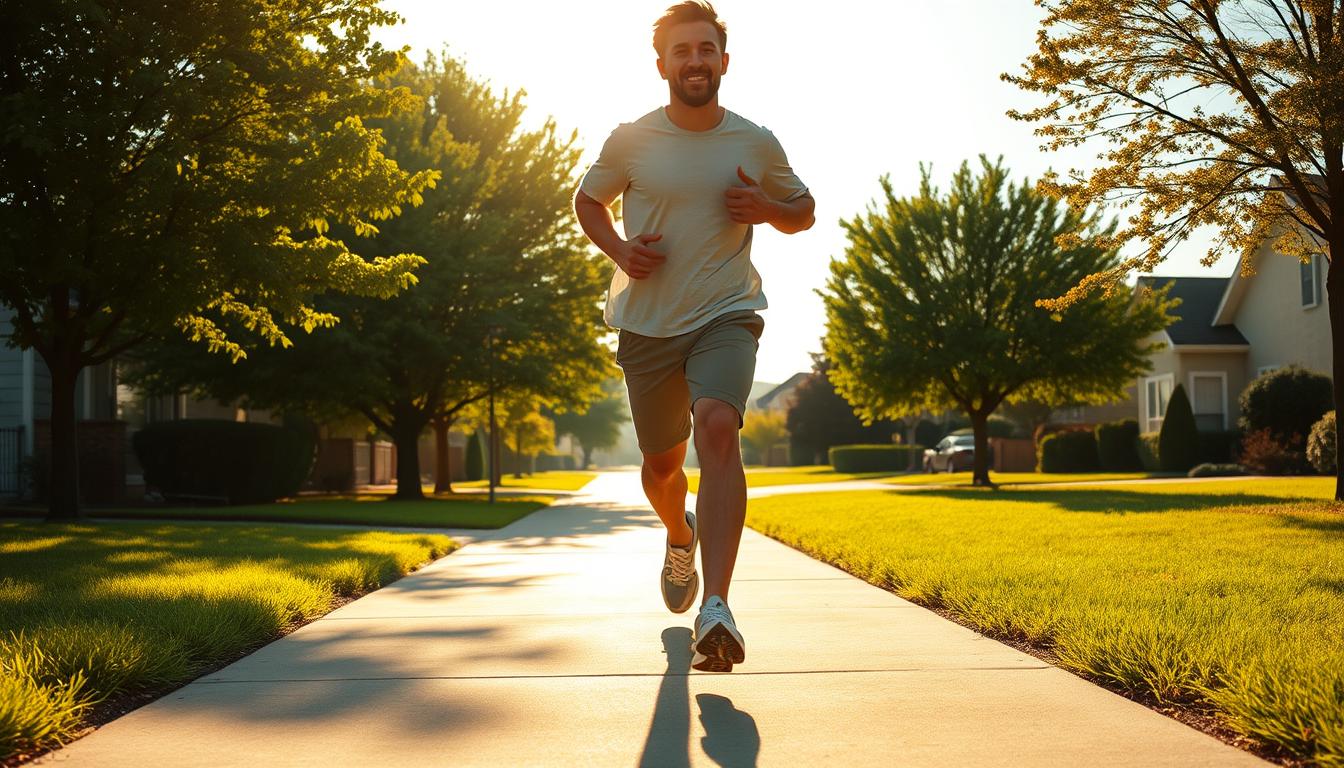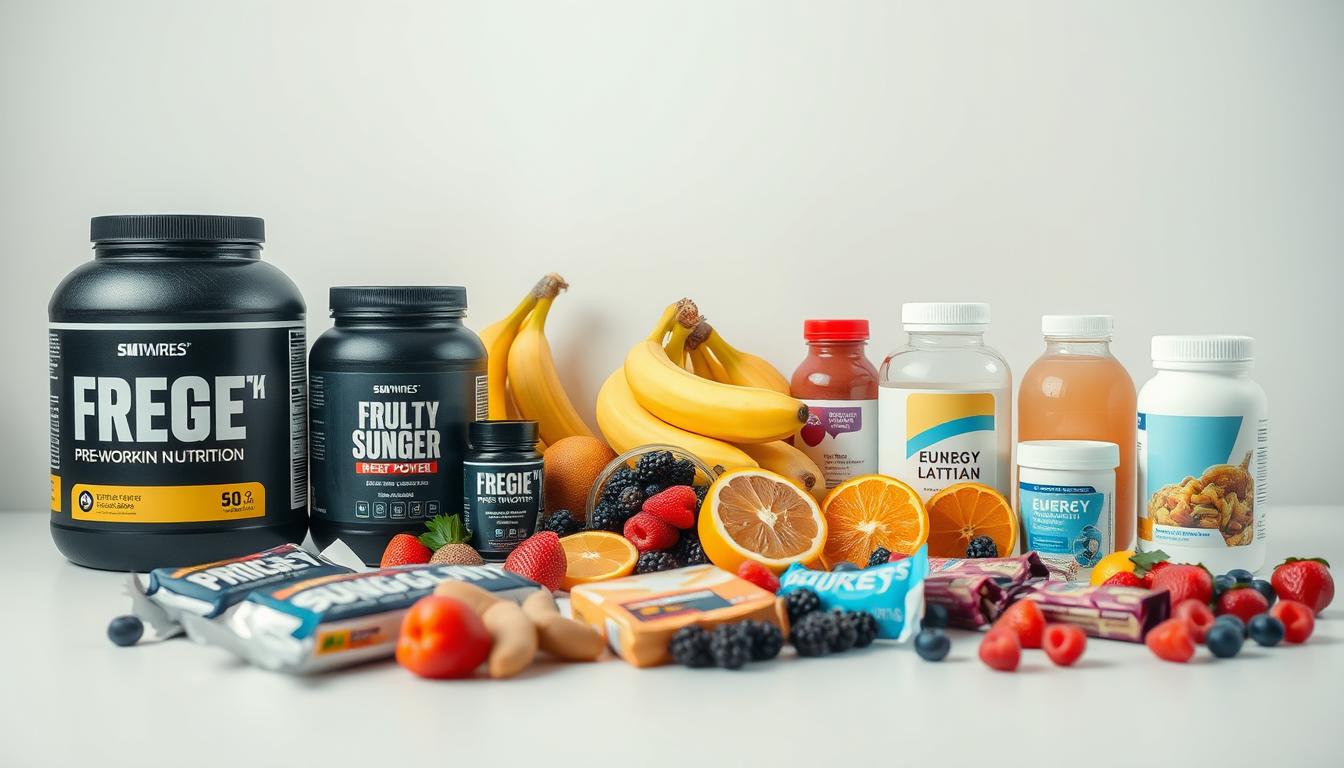Are you finding it hard to lose weight with your busy life? You’re not alone. Many people struggle to find good weight loss strategies when they’re always on the go.
But what if you could use a simple, yet powerful, way to lose weight? Walking is easy and can help you burn calories and get healthier. It’s a great weight loss strategy for those with little time.
You don’t need to be a fitness expert or spend hours at the gym. By adding walking for weight loss to your daily routine, you can move closer to a healthier life.
Key Takeaways
- Walking is a simple and effective weight loss strategy.
- It can be easily incorporated into a busy schedule.
- Regular walking can improve overall health and well-being.
- It’s an accessible form of exercise for individuals of all fitness levels.
- Consistency is key to achieving weight loss goals through walking.
The Power of Walking for Weight Management
Walking is a great way to lose weight, especially for beginners. It’s easy on the joints compared to running. This makes it perfect for those new to exercise or with mobility issues.

Regular walking can lead to big weight loss benefits. It improves heart health and burns calories. Adding walking to your daily routine is a great first step towards a healthier life.
Why Walking Is Effective for Fat Loss
Walking is good for fat loss because it burns calories. Even at a slow pace, it helps you lose weight. A fitness expert says, “Walking is a foundational exercise that can be adapted to various fitness levels, making it a versatile tool for weight management.”
The Accessibility Factor: Walking vs. Other Exercises
Walking doesn’t need special equipment or a gym membership. You can walk almost anywhere, anytime. This makes it perfect for busy people or those without access to gyms. Walking’s accessibility boosts its weight loss benefits a lot.
Walking for Weight Loss: The Underrated Strategy Busy People Overlook
Busy people often miss out on a simple way to lose weight: walking. It’s easy to do but often gets ignored for more intense workouts.

Common Misconceptions About Exercise Intensity
Many think you need high-intensity workouts to lose weight. But studies show brisk walking is just as good. Walking burns calories, improves heart health, and boosts metabolism.
Busy folks might think they need tough workouts to lose weight. But the truth is, it’s about being consistent and finding something you can keep up with.
Why We Dismiss Simple Solutions in Favor of Complexity
We often prefer complicated plans over simple ones. We think the harder it is, the better it must be. But with weight loss, simple habits like walking can work wonders. Regular walking can lead to big results over time.
| Exercise Type | Intensity Level | Caloric Burn |
|---|---|---|
| Walking | Moderate | 150-200 calories/mile |
| Running | High | 600-800 calories/hour |
| Swimming | Variable | 450-700 calories/hour |
By understanding walking’s benefits and clearing up myths, busy people can start a simple yet effective weight loss plan. It fits easily into their busy lives.
The Science Behind Walking and Weight Loss
Walking is more than just a daily activity. It’s a powerful exercise that can help you lose weight. When done right, it can be a key part of your fitness journey.
Caloric Expenditure During Different Walking Speeds
Walking speed affects how many calories you burn. The faster you walk, the more calories you lose. For example, a brisk walk burns more calories than a slow one.
This knowledge helps you adjust your walking routine for better weight loss.
| Walking Speed | Calories Burned per Hour (approx.) |
|---|---|
| Leisurely (2 mph) | 120-140 |
| Average (3 mph) | 180-200 |
| Brisk (4 mph) | 240-280 |
Metabolic Benefits Beyond Calories
Walking does more than just burn calories. It also improves insulin sensitivity and fat metabolism. These benefits help with weight loss over time.
Walking vs. High-Intensity Exercise for Sustainable Fat Loss
High-intensity exercise burns calories, but walking is a gentler option. It’s easier to keep up with walking over time. This makes walking a great choice for those who want to lose weight without too much effort.
Walking helps you find a balance between working out and resting. This leads to more lasting fat loss.
How Walking Fits Into a Busy Lifestyle
Walking is easy and can fit into any busy schedule. You can add daily walks to your routine. This way, you get many walking benefits without spending a lot of time.
Time-Efficient Walking Strategies for Professionals
Busy professionals often struggle to find time to exercise. But, short walks can be a great solution. Try walking during your lunch break or use a walking desk at work.
Integrating Walking Into Your Daily Routine Without Extra Time
You can make walking a part of your daily life without adding extra time. Here are some tips:
Walking Meetings and Calls
Make meetings or calls a chance to walk. It’s good for your health and can help you think better.
Commute Integration Techniques
Walking part or all of your commute is a good idea. If that’s hard, try getting off the bus a stop early and walking the rest of the way.
| Walking Strategy | Benefits |
|---|---|
| Walking Meetings | Increased productivity, creativity |
| Commute Integration | More physical activity, reduced transportation costs |
| Lunch Break Walks | Improved health, reduced stress |
Creating Your Personalized Walking Plan
Making a walking plan that fits your life and fitness is key for weight loss. You need to think about your current fitness, goals, and how to challenge yourself more.
Determining Your Starting Fitness Level
First, check your current fitness level. Look at your walking speed, how long you can walk, and any physical limits. Try walking briskly for 10-15 minutes and see how you feel. This will help you make your walking plan better.
Setting Realistic Weekly Walking Goals
Setting goals you can reach is key to staying motivated. Start with a goal like walking for 30 minutes, three times a week. As you get better, you can walk more often and longer. Keeping a walking log or using an app can help you track your progress.
| Week | Walking Frequency | Walking Duration |
|---|---|---|
| 1-2 | 3 times | 30 minutes |
| 3-4 | 4 times | 35 minutes |
| 5-6 | 5 times | 40 minutes |
Progressive Overload: Safely Increasing Your Walking Capacity
To keep improving, you need to make your walks harder. You can do this by walking uphill, walking faster, or adding quick bursts of speed. Progressive overload makes your walks more challenging and helps with weight loss.
By following these steps and making a walking plan that’s just for you, you can use walking as a weight loss strategy that works for your lifestyle and goals.
Optimizing Your Walking Technique for Maximum Results
To get the most out of your walking exercise, it’s crucial to optimize your technique. A well-executed walking routine not only enhances your overall experience but also maximizes the weight loss benefits. By paying attention to a few key aspects, you can significantly improve your walking efficiency.
Proper Posture and Form for Efficient Calorie Burning
Maintaining proper posture is essential for efficient calorie burning. Keep your head up, shoulders relaxed, and engage your core. This posture helps in maximizing your stride length and reduces the risk of injury. Good form also ensures that you’re using the correct muscles, thereby optimizing your energy expenditure.
Stride Length, Arm Movement, and Pace Considerations
Your stride length and arm movement play a significant role in determining your walking efficiency. Aim for a natural stride length and keep your arms relaxed, with a slight bend at the elbows. Your pace should be brisk enough to raise your heart rate but still allow you to hold a conversation. Experimenting with different paces and incorporating short bursts of faster walking can also enhance your
Enhancing Your Walking Routine for Greater Weight Loss
Looking to boost your weight loss? Start by tweaking your walking routine. A consistent walking routine can lead to significant weight loss. But, it’s key to challenge your body to avoid plateaus.
Interval Walking for Increased Calorie Burn
Interval walking mixes high-intensity walking with regular walking. This boosts calorie burn and heart health.
30-Second Sprint/Recovery Pattern
Try the 30-second sprint/recovery pattern. Walk fast for 30 seconds, then slow down for 30 seconds. Keep repeating this during your walk.
Hill Repeat Protocol
For hill repeats, find a hilly route. Walk briskly uphill, then recover on flat or downhill paths. This increases calorie burn and strengthens your legs.
Adding Inclines and Varied Terrain to Challenge Your Body
Adding inclines and varied terrain challenges your muscles and heart. Try walking on trails or uneven surfaces to work your stabilizers and balance.
Incorporating Strength Elements Into Your Walks
Use wearable weights, resistance bands, or bodyweight exercises to add strength to your walks. For example, do squats or lunges at specific points.
By adding these elements to your walks, you can avoid missing out on overlooked weight loss chances. Keep moving toward your weight loss goals.
Essential Gear and Equipment for Walking Success
For busy people trying to lose weight, the right walking gear is key. It makes walking more fun and helps you reach your goals.
Choosing the Right Footwear for Your Walking Style
Finding the right shoes is vital for a good walking routine. Choose shoes with good arch support and cushioning to avoid injuries. A good pair of walking shoes is a smart investment for weight loss.
Look for shoes made for walking. They offer the support and stability you need.
- Breathable materials to keep your feet cool and dry
- A comfortable, snug fit to prevent blisters
- Supportive arches to reduce strain on your feet
Weather-Appropriate Clothing and Useful Accessories
Wearing the right clothes for the weather makes walks better. Moisture-wicking clothes are great for hot days, and layered clothes are best for cool days. Don’t forget a hat, sunglasses, and sunscreen for sun protection.
- Choose clothing that allows for a full range of motion
- Consider reflective or bright clothing for visibility
- Use accessories like armbands or waist packs for carrying essentials
Investing in the right gear makes walking better. It’s a great weight loss tip for your fitness journey.
Tracking Your Progress and Staying Motivated
Tracking your daily walks helps you see how far you’ve come. It also keeps you motivated. Having a way to measure your success is key to staying on track.
Using Technology to Monitor Walking Distance and Calories
Technology can make walking better. There are many tools and apps that track your steps, calories, and more.
Best Apps for Walking Tracking
Top apps for walking include Fitbit Coach, MyFitnessPal, and MapMyWalk. They help you track steps, plan routes, and count calories. This makes it easy to see your progress.
Wearable Technology Options
Devices like Fitbit and Apple Watch give you updates on your walks. They track distance and calories. These gadgets are great for keeping you on track.
Non-Scale Victories to Celebrate Along Your Journey
Weight loss is important, but there are other wins too. These non-scale victories can really motivate you. They help you keep walking.
Look out for more energy, better mood, and feeling overall well. Celebrating these wins keeps you motivated. It encourages you to keep walking every day.
Overcoming Common Walking Challenges
Walking is a great way to lose weight, but you might face some hurdles. Knowing these obstacles and how to beat them is key to reaching your weight loss goals.
Weather Obstacles and Indoor Walking Alternatives
Bad weather can stop you from walking. But, you can walk indoors on a track, treadmill, or even in place at home. You might also try mall walking or use indoor walking apps for virtual routes.
Dealing with Plateaus in Walking-Based Weight Loss
Reaching a plateau can be tough, but it’s part of losing weight. To get past it, mix up your walks with interval training or new routes. This keeps your walks fun and challenges your body.
Managing Time Constraints Effectively for Busy Professionals
Busy people often struggle to find time to walk. But, you can fit walking into your day, like during lunch or while commuting. You can also walk in shorter, easier-to-handle bits throughout the day.
By tackling these common issues, you can keep walking regularly and keep moving toward your weight loss goals. With determination and the right tactics, walking can stay a valuable part of your weight loss journey.
Combining Walking with Complementary Weight Loss Strategies
For a complete weight loss plan, mix walking with better eating and strength exercises. This combo helps you lose weight better and keeps it off longer.
Nutritional Considerations for Walking-Based Weight Loss
Good nutrition is key when you’re walking to lose weight. Eat lots of whole foods like veggies, fruits, lean meats, and whole grains. Drinking water all day is also important. Here are some nutrition tips:
- Eat foods high in protein to help muscles grow and heal
- Add healthy fats like nuts and avocados for energy
- Try to avoid processed foods and sugary snacks
Strength Training as a Walking Supplement for Busy People
Adding strength training to your routine can really help with weight loss. Busy folks can do this with:
- Bodyweight exercises that you can do at home or on breaks
- Resistance band workouts that are easy to carry and use anywhere
- Short, intense strength sessions that fit with your walking schedule
Walking and strength training together can help you build muscle, increase your metabolism, and speed up weight loss.
Conclusion: Taking the First Step Toward Sustainable Weight Loss
Adding a walking routine to your day can be a strong weight loss tip. You can make a plan that fits your life by learning about walking and weight loss. Start with achievable goals and slowly increase how much you walk.
To get the best results, work on your walking technique. Add interval training and strength exercises to your walks. Also, keep track of your progress. With the right approach and a good walking plan, you can lose weight and get healthier.
Start your journey to a healthier life with a simple walk. It’s the first step to a more active and healthy lifestyle. Walking regularly will help you reach your weight loss goals and keep a healthy weight over time.


